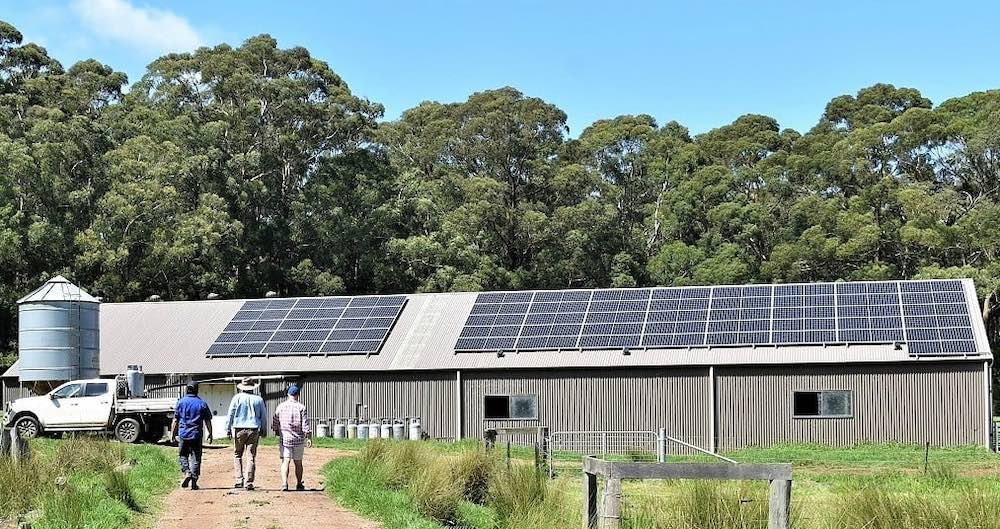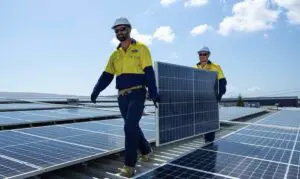There are plenty of farmers around Australia who are “all-in” on investing in alternative energy sources to power their operations, but there are also plenty of barriers that can make the task difficult and the result disappointing.
Queensland farmer Laurie Brosnan, from the BettaPork piggery in Biloela, told the 2024 National Renewables in Agriculture conference in Toowoomba last week how his family business invested millions in a biogas plant to produce power for its operations while also solving some of its pig-poo disposal problems.
Based on research of technology used in Germany, the farm’s pair of three million litre biogas tanks take in 120,000 litres of organic waste a day, including 16,000 pigs’ worth of effluent, and produces the same amount in biogas.
In electricity terms, the biogas plant currently supplies up to 200kW worth of power – enough for a full night and a half day’s power demand for the entire farm including the entire family’s housing – and also produces heat used to keep piglets warm.
Apart from being very clever and slashing the farm’s energy bills from up to $80,000 a month to $130 a month, BettaPork’s biogas plant is a local curiosity that Brosnan says attracts about 200 visitors a year, ranging from uni students to kids from the local kinder.
“It’s really easy to explain to kindergarten kids,” Brosnan told the conference.
“Basically, the the bacteria lives in the tank. We feed it. It farts. We capture the fart … it goes down a stainless steel pipe …goes through activated carbon filter pellets, takes out the hydrogen sulfide and that goes into the engines – two 100 kilowatt engines (basically bus engines converted) and that creates electricity and it goes into our network.”

Source: BettaPork
But next to the jaw-dropping energy bill savings for the farm, which is still connected to the local regional Queensland grid, are a number of “small asterisks,” as Brosnan puts it, that take the cream off the top of being energy independent.
First, there is the upfront cost of going from being a pig producer to a power producer.
“One of the things that’s overlooked considerably is, when you’re doing your budgets … is that we had to buy back our network …. the 11 KV power line that ran on the inside our farm with all the transformers,” Brosnan told the conference.
“So that was an oversight of over $200,000 by an …engineering procurement contractor… someone that was meant to know what they were doing to tell us, ‘Oh, that’s easy. You just connect into the grid.’
“It’s not easy. It’s definitely not easy.”
Meanwhile, Brosnan says, while the farm’s energy bills were going down, its network charges were going up and up.
“The more power …that we don’t consume from the network then someone has to pay for [it]. … So our network charges at the moment, in just the last month, have gone from $7,000 to $9,000 a month. And they’ve told us it’s going to increase.”
There are also strict limitations on what the piggery’s power plant can sent to the grid.
“So we can’t just export power whenever we want. And when the power goes off we can’t produce power,” Brosnan says.
The latter problem, which is a safety precaution for the network and its workers during outages, means needing backup diesel generators on site, to continue to run the biogas plant while the grid is down, to keep the tanks constantly stirring.
“The other thing is we do not get paid for our electricity that we pump into the network, because where we are in central Queensland, the Queensland government doesn’t have to pay us so they don’t pay us.
“So we flare [burn off excess biogas] where we can and we use it as a management tool when our motors come on and off,” Brosnan says, an outcome he describes as “disappointing, sad, pathetic; all those words rolled into one.
“It really, pardon the pun, hamstrings any further development of our business.”
Brosnan says the decision to flare the gas, rather than send it to the grid for no payment, has been forced by a lack of options from the network.
He says that around 10 years ago, the Queensland government – though state-owned network company Ergon – that the piggery would be able to share its excess biogas-generated electricity potentially in the next coming 12 months.
In particular, the Brosnan family were looking to use it to help power a satellite farm 42km away, to offsets the power costs of its operations.

Laurie Brosnan. Source: PettaPork
“That was 10 years ago. Nothing has happened since and I really don’t think it’s going to,” Brosnan said.
“I really hope that it does, because it’s a very large bill out there. We’re actually looking at putting on 120kW worth of solar over there. But again, because we’re commercial there’ll be a zero net zero export that we’re allowed to do.”
Disappointments and frustrations aside, the BettaPork piggery turned clean power producer has no plans for a change of course.
“In the future we’ll be looking for other revenues or avenues of interest to increase our gas production, to increase our power production,” Brosnan told the conference.
“Our plant’s big enough for one megawatt but we’re limited with our export of power due to constraints with the network.”
But Queensland networks are not alone in putting up barriers.
In New South Wales, a sheep dairy and boutique cheese maker came up against similar issues when it turned to solar and battery storage to cut power costs and farm more sustainably.
The Pecora Dairy in Robertson in the NSW Southern Highlands installed 28 kW of solar, a 40-kWh Redflow battery system and a new heat pump to replace the site’s LPG boiler to overcome the energy supply issues and outages that had threatened its processing operations.
Since then, the solar and battery system has been combined with a peer-to-peer (P2P) energy trading platform to sell and buy excess solar electricity with other users, to overcome its own network challenges.
“I’m all in on renewables in agriculture because I believe in making family farms more viable and resilient,” Cressida Cains, who co-founded and co-owns the dairy business with her husdand, told the Toowoomba conference.

Cressida Cains
But what she has found is an “arcane and unfit for purpose” national energy market that makes switching to renewables hard and unrewarding.
“I’ve gained a wide circle of farming colleagues and I’ve asked them why they don’t invest more in renewables, even if it is just to lower their own energy bills.
“In other words, what’s the biggest barrier to uptake of more renewable infrastructure?
“It turns out that most farmers have typically multiple metering points across their land. A typical mixed cropping enterprise might have say 10 or 15 metering points.
“In practice, if a farmer wants to generate, say, solar power at one part of their property and use it to irrigate at different metering points on the same property, they’d have to sell it into the grid at five cents and then buy it back at 35 cents, though the energy never left the farm.
“Lack of equity aside, this creates a powerful disincentive to have renewable energy infrastructure on a farm because the return on investment isn’t there in the same way that it would be if you were drawing all your power from a single metering point.”
In her own case, for example, Cains says that if she generates power at the dairy, and needs to trade it 50 meters away to her house ,which is on a different lot, she is looking at having to pay exorbitant transmission costs.
“You can see the problem. Why can’t we have a market that’s flexible enough to trade energy to yourself, your neighbor, your community? What’s at the core of the problem? Is it the power of gentailers or a slow to act government?
“Australian agriculture can be a powerful force but policy changes are required. For example, allowing farmers to share power across all their meters without paying transmission costs,” Cains said.
“Renewables in agriculture will go a long way to creating a stable network and an acceleration in the adoption of renewables will at the same time allow family farms to be more viable.”








